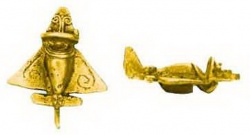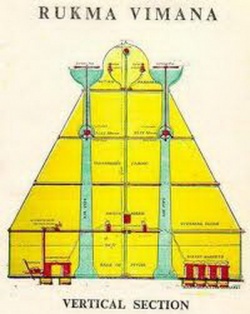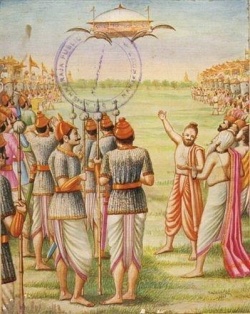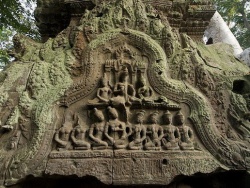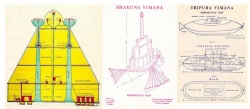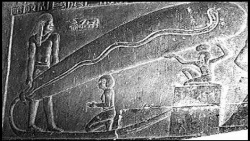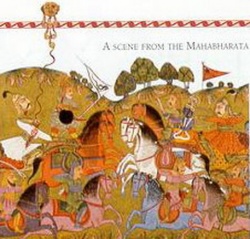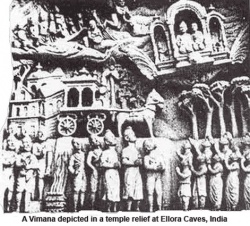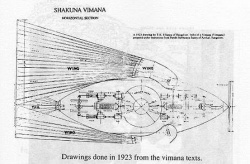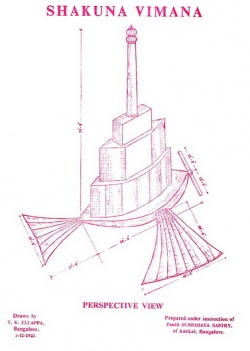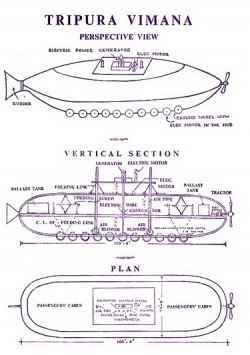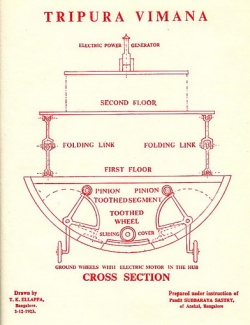The Story of Vimanas
The Story of Vimanas
By: Dr. Srikumar V. Gopalakrishna
In the Vedic literature of India, there are many descriptions of flying machines that are generally called vimanas. These fall into two cate- gories: (l) manmade craft that resemble airplanes and fly with the aid of birdlike wings, and (2) unstreamlined structures that fly in a mysterious manner and are generally not made by human beings. The machines in category (l) are described mainly in medieval, secular Sanskrit works dealing with architecture, automata, military siege engines, and other mechanical contrivances. Those in category (2) are described in ancient works such as the Rg Veda, the Maha-bha-rata, the Rama-yana, and the Pura-nas, and they have many features reminis- cent of UFOs. In addition, there is one book entitled Vaima-nika-sa-stra that was dictated in trance during this century and purports to be a transcription of an ancient work preserved in the akashic record. This book gives an elaborate description of vimanas of both categories.
In this chapter, I will survey some of the available literature on vima-nas, beginning with the texts dating from late antiquity and the medieval period. The latter material is described in some detail by V. Raghavan in an article entitled "Yantras or Mechanical Contrivances in Ancient India." I will begin by discussing the Indian lore regarding machines in general and then turn to flying machines.
Mathines in Antienl and Medieval India
In Sanskrit, a machine is called a yantra. The word yantra is defined in the Samarangana-sutradhara of King Bhoja to be a device that "con- trols and directs, according to a plan, the motions of things that act each according to its own nature." I There are many varieties of yantras. A simple example would be the taila-yantra, a wheel that is pulled by oxen around a circular track to crush seeds and extract their oil. Other examples are military machines of the kind described in the Artha- sastra of Kautilya, written in the 3rd century B.C. These include the sarvato-bhadra, a rotating wheel that hurls stones, the sara-yantra, an arrow-throwing machine, the udghatima, a machine that demo,ishes wa,ls using iron bars, and many more.
These machines are all quite understandable and believable, but there are other machines that seem less plausible from the point of view of modern historical thinking. Thus Raghavan mentions a device that could create a tempest to demoralize enemy ranks.2 Such a weapon is also mentioned by the third-century Roman writer Flavius Philostratus, who described sages in India who "do not fight an invader, but repel him with celestial artillery of thunder and lightning, for they are holy and saintly men."3 Philostratus said that this kind of fire or wind weapon was used to repel an invasion of India by the Egyptian Hercules, and there is an apocryphal letter in which Alexander the Great tells his tutor Aristotle that he also encountered such weapons.4
Modern scholars tend to regard Philostratus's work as fictitious, but it does demonstrate that some people in Roman times were circu- lating stories about unusual fire or wind weapons in India. In ancient epics such as the Mahabharata, there are many references to remarkable wind weapons such as the vayavya-astra and fire weapons such as the sataghni (or "10(' killer"). In general, the weapons described in older works tend to be more powerful and remarkable than those described in more recent works. Some ascribe this to the fantastic imagination of ancient writers or their modern redactors. But it could also be explained by a progressive loss of knowledge as ancient Indian civilization became weak- ened by corruption and was repeatedly overrun by foreign invaders.
It has been argued that guns, cannons, and other firearms were known in ancient India and that the knowledge gradually declined and passed away toward the beginning of the Christian era. This is discussed extensively in a book by Gustav Oppert.s
Robots and Other Automotn
Robots form another category of remarkable machines. There are many stories in secular Sanskrit literature involving a yantra-purusa, or machine-man, that can behave just like a human being. An example Mothines in Ancient ond Nledievol Indio is the story in the Buddhistic Bhaisajya-vastu, in which a painter went to the Yavana country and visited the home of a yantracarya, or teacher of mechanical engineering. There he met a machine-girl who washed his feet and seemed human, until he found that she could not speak.6
Fantastic-sounding robots of this sort often appeared in fictional stories intended for entertainment, and thus they had the same status as the robots of modem science fiction. However, there are many descrip- tions of quite believable automata that were actually constructed and used in the palaces of wealthy kings. These include: singing and danc- ing birds, a dancing elephant, elaborate chronometers with moving ivory figures, and an astronomical instrument showing the movements of the planets.7
The designs of these automata are similar to those of the automata that were popular in Europe in the eighteenth century. Here is a de- scription taken from the twelfth-century Samararigana-sutradha-ra:
Male and female figures are designed for various kinds of auto- matic service. Each part of these figures is made and fitted sepa- rately, with holes and pins, so that thighs, eyes, neck, hand, wrist, forearm and fingers can act according to need. The material used is mainly wood, but a leather cover is given to complete the im- pression of a human being. The movements are managed by the system of poles, pins and strings attached to rods controlling each limb. Looking into a mirror, playing a lute and stretching out the hand to touch, give pan, sprinkle water and make obeisance are the acts done by these figures.8
Apart from their practical applications, robots also provided a metaphor for the relationship between the soul and the body. Thus, in the Bhagavad-glta-, Krsna says,
The Supreme Lord is situated in everyone's heart, O Arjuna, and is directing the wanderings of all liv,ng entities, who are seated as on a machine (yantra) made of the material energy. 9
Raghavan, for his part, found this metaphor regrettable. He lamented that in other countries machines led to a materialistic civilization, but in India they only reinforced the idea of God and Spirit. Thus, "even writers who actually dealt with the yantras, like Somadeva and Bhoja, saw in the machine operated by an agent an appropriate analogy for the mundane body and senses presided over by the Soul, and for the wonderful mechanism of the universe, with its constituent elements and planetary systems, requiring a divine master to keep it in constant revolution." 1¡
Airplanes
There are many stories in medieval Indian literature about flying machines. Thus in Bana's Harsa-carita there is the story of a Yavana who manufactured an aerial machine that was used to kidnap a king. Likewise, Dandl's Avanti-sundar tells of an architect named Mandhata who used an aerial car for such casual purposes as traveling from a distance to see if his young son was hungry. His son, by the way, was said to have created mechanical men that fought a mock duel and an artificial cloud that produced heavy showers. Both of these works date from about the 7th century A.D.t1
In the ninth to tenth centuries, Buddhasvamin wrote a version of the Brhat-kathd, a massive collection of popular stories. Buddhasvamin spoke of aerial vehicles as dkdsa-yantras, or sky-machines, and he attributed them to the YavanasÑa name often used for barbaric foreigners. It was quite common for flying machines and yantras in general to be attributed to the Yavanas in Sanskrit texts.t2
Some scholars take the Yavanas to be the Greeks, and they attribute Indian stories of machines to a Greek origin. For example, Penzer thought that the Greek philosopher Archytas (c. 42347 B.C.) may have been the "first scientific inventor" of devices resembling the Indian yantras, and he pointed out that Archytas "constructed a kind of flying machine, consisting of a wooden figure balanced by a weight suspended from a pulley, and set in motion by hidden and enclosed air." 3
No doubt there was much exchange of ideas in the ancient world, and today it is hard to know for sure where a given idea was invented and how highly developed it became. We do know, however, that fairly detailed ideas concerning airplanelike flying machines were known in medieval India.
Bhoja's Samardngana-sutradhdra states that the main material of a flying machine's body is light wood, or laghu-ddru. The craft has the shape of a large bird with a wing on each side. The motive force is
Mothines in Antient ond Medievol Indio provided by a fire-chamber with mercury placed over a flame. The power generated by the heated mercury, helped by the flapping of the - wings by a rider inside, causes the machine to fly through the air. Since the craft was equipped with an engine, we can speculate that the flap- ¥ ping of the wings was intended to control the direction of flight rather than provide the motive power.
A heavier (alaghu) da-ru-vimdna is also described. It contains four pitchers of mercury over iron ovens. "The boiling mercury ovens pro- duce a terrific noise which is put to use in battle to scare away elephants. By strengthening the mercury chambers, the roar could be increased so that by it elephants are thrown completely out of control." 14
There has been a great deal of speculation about just how power generated by heating mercury might be used to drive the vimdna through the air. This was discussed in an early book on UFOs by Desmond Leslie and George Adamski.ls Leslie proposed that the heated mercury mentioned in the Samardngana-sutradhdra may have something to do with the flight of UFOs.
I would suggest that the vimdnas described by Bhoja are much more similar to conventional airplanes than to UFOs. Thus they are made of ordinary materials like wood, they have wings, and they fly like birds. Raghavan suggested that the mercury engine was intended to be a source of mechanical power for flapping the wings as in bird flight. He supported this by noting that Roger Bacon described a flying machine in which some kind of revolving engine caused wings to flap through a mechanical linkage.S
Ramachandra Dikshitar, however, said that according to the Sama- rdngana-sutradhdra, the vimdna "has two resplendent wings, and is pro- pelled by air." 17 This suggests that some kind of jet propulsion was used.
However these vimdnas were actually powered, it seems likely that they relied on some conventional mechanical method that extracted energy from burning fuel and used it to produce a flow of air over wings. We can contrast this with the flight characteristics of UFOs, which don't have wings, jets, or propellers, and seem to fly in a manner that contradicts known physical principles. 1 Were the vimdnas mentioned in Samardrigana-sutradhdra ever actually built, or were they just products of imagination? I don't know. However, the elaborate descriptions of yantras found in medieval Indian texts suggest that many sophisticated machines were made in India long ago. If sophisticated mechanical technology was known in remote times, then it is quite possible that airplanes of some kind were a,so bui,t. It is interesting that the Sanskrit astronomical text entitled Surya- siddhdnta mentions a mercury engine used to provide rotary motion for a gola-yantra, a mechanical model of the planetary system.'8 This suggests that at least one kind of mercury engine was used to produce rotary power. The text also says that the design for the mercury en- gine is to be kept secret. It was standard practice in ancient India for technical knowledge to be passed down only from teacher to trusted disciple. An unfortunate consequence of this is that knowledge tended to be lost whenever oral traditions depending on teachers and disciples were broken. It is thus quite possible that many arts and sciences known in ancient times have been lost to us, practically without a trace.
Additional Sanskrit works referring to flying machines are listed in a book by Dileep Kanjilal.9 These are: the Yukti-kalpataru by Bhoja (twelth century A.D.); the Mayamatam attributed to Maya Dfinava but probably dating to the twelth century A.D.; the Kathdsaritsdgara (tenth century A.D.); the Avaddna literature (first-third centuries A.D.); the Raghuvamsam and Abhijndna-sakuntalam of Kalidasa (first century B.C.); the Abhimdraka of Bhasa (second century B.C.); and the Jdtakas (third century B.C.). These dates are often approximate, and the material in the various works is often taken from older works and traditions.
The Vaimaniko-Sastra
The Vaimdnika-sdstra is a highly detailed description of vimdnas, and it is given great credence in a number of books and articles. These include the writings of Kanjilal,2¡ Nathan,2' and Childress.22 In particular, the Indian ufologist Kanishk Nathan wrote that the Vaimdnika-sdstra is an ancient Sanskrit text that "describes a technology that is not only far beyond the science of the times but is even way beyond the possible conceptua, scientific imagination of an ancient Indian, including concepts such as solar energy and photography." 23
It is indeed true that this book contains many interesting ideas about aerial technology. But it is important to note that it was written in the early 20'h century by a psychic process known today as channeling.
The story behind this is presented in the introduction to G. R. Josyer's translation of the Vaimdnika-sdstra. There it is explained that knowledge in India used to be transmitted orally, but as this tradition died out, writing on palm leaves was used. Unfortunately, palm leaf manuscripts do not last very long in the Indian climate, and large volumes of old written material have been lost due to not being regularly recopied.
This is certainly true. But Josyer went on to say that the lost texts "remain embedded in the ether of the sky, to be revealedÑlike televi- sionÑto gifted mediums of occult perception." The medium in this case was Pandit Subbaraya Sastry, a "walking lexicon gifted with occult perception," who began to dictate the Vaimdnika-sdstra to Mr. Venkatachala Sarma on August 1,1918. The complete work was taken down in 23 exercise books up to August 23, 1923. In 1923, Subbaraya Sastry also had a draftsman prepare some drawings of the vimdnas according to his instructions.24
According to Subbaraya Sastry, the Vaimdnika-sdstra is a section of t a vast treatise by the sage Maharsi Bharadvaja entitled Yantra-sarvasva or the ncyclopedia of Machines. Maharsi Bharadvaja is an ancient .rsi mentioned in the Mahdbhdrata and other Vedic works, but I do not know of any reference indicating that he was concerned with machines. The Yantra-sarvasva is no longer extant in physical form, but it is said to be existing in the akashic record, where it was read and recited by Subbaraya
t Sastry. As far as I am aware, there are no references to this work in existing literature. This is discussed in Kanjilal's book on vimdnas.25 - Although the Vaimdnika-sdstra could be a hoax, I have no reason 'J@ to suppose that it was not dictated by Subbaraya Sastry in the manner described by Josyer. But is the work authentic? Even if it was existing as a vibrational pattern in the ether, during the process of psychical reading and dictation it might have been distorted or adulterated by material from the unconscious mind of the medium.
In fact, there are good reasons for thinking this might be the case. The text of the Vaimdnika-sdstra is illustrated by several of the drawings made under Subbaraya Sastry's supervision. These include cross sections of the rukma-vimdna, the tripura-vimdna, and the sakuna- vimdna These cross sections show the kind of crude mechanical and E - electrical technology that existed in the period just following World War I. There are large electromagnets, cranks, shafts, worm gears, pis- tons, heating coils, and electric motors turning propellers. The rukma-vimdna is supposedly lifted into the air by "lifting fans" that are powered by electric motors and that are very small compared with the size of the vimdna as a whole. It definitely does not look as though it could fly.
These mechanical devices may well have been inspired by the technology of the early 20th century. But if we turn to the text of the Vaimdnika-sdstra, we encounter material of a much different nature. To illustrate this, here are ten examples taken from a list in the Vai- mdnika-sdstra of 32 secrets that a vimdna pilot should know.26 I will comment on relations between these items and common features of the UFO phenomenon.
1. Goodha: As explained in "Vaayutatva-Prakarana," by harnessing the powers, Yaasaa, Viyaasaa, Prayaasaa in the 8'h atmospheric layer cov- ering the earth, to attract the dark content of the solar ray, and use it to hide the Vimaana from the enemy.
2. Drishya: By collision of the electric power and wind power in the atmosphere, a glow is created, whose reflection is to be caught in the Vishwa-Kriyaa-darapana or mirror at the front of the Vimana, and by its manipulation produce a Maaya-Vimaana or camouflaged Vimana.
3. Adrishya: According to "Shaktitantra," by means of the Vynarathya Vikarana and other powers in the heart centre of the solar mass, attract the force of the ethereal flow in the sky, and mingle it with the balaahaa-vikarana shakti in the aerial globe, producing thereby a white cover, which will make the Vimana invisible.
Here three methods are described for hiding a vimdna from the enemy. They sound fanciful, but it is interesting to note that vimdnas described in the Purdnas and the Mahdbhdrata have the ability to become invisible. This is also a characteristic feature of UFOs, but this was certainly not well known in 1923.
The idea that a glow is created by the collision of electrical power and the wind is interesting. UFOs are well known for glowing in the dark, and this may be due to an electrical effect that ionizes the air surround- ing the UFO. The word "shakti" (sakti) means power or energy.
4. Paroksha: According to "Meghotpatthi-prakarana," or the science of the birth of clouds, by entering the second of the summer cloud layers, and attracting the power therein with the shaktyaakarshana darpana or force-attraction mirror in the Vimana, and applying it to the parivesha or halo of the Vimana, a paralyzing force is generated, and opposing Vimanas are paralyzed and put out of action.
Aparoksha: According to "Shakti-tantra," by projection of the Rohi- nee beam of light, things in front of the Vimana are made visible.
Beams of paralyzing force are often mentioned in UFO accounts, as well as beams of light. The mention of a halo around the vimdna may be significant, since UFOs are often said to be surrounded by some kind of energy field.
6. Viroopa Karena: As stated in "Dhooma Prakarana," by producing the 32nd kind of smoke through the mechanism, and charging it with the light of the heat waves in the sky, and projecting it through the padmaka chakra tube to the bhyravee oil-smeared Vyroopya-darpana at the top of the Vimana, and whirling with 132nd type of speed, a very fierce and terrifying shape of the Vimana will emerge, caus- ing utter fright to onlookers.
7. Roopaantara: As stated in "Tylaprakarana," by preparing griddhra- jihwaa, kumbhinee, and kaakajangha oils and anointing the distorting mirror in the Vimana with them, applying to it the l9th kind of smoke and charging with the kuntinee shakti in the Vimana, shapes like lion, tiger, rhinoceros, serpent, mountain, river will appear and amaze observers and confuse them.
Although these descriptions seem completely wild, it is interesting that UFOs have been known to change shape in mysterious ways, and monstrous creatures have been known to emerge from landed UFOs and frighten people (see pages 331-33). Many of the items in this list of secrets have to do with creating illusions that bewilder enemies, and it seems that UFOs also create such illusions.
8. Saarpa-Gamana: By attracting the dandavaktra and other seven forces of air, and joining with solar rays, passing it through the zig-zagging centre of the Vimana, and turning the switch, the Vimana will have a zig-zagging motion like a serpent.
The ability of UFOs to fly in a zig-zag fashion is well known today, but it wasn't widely known in 1923.
9. Roopaakarshana: By means of the photographic yantra in the Vimana to obtain a television view of things inside an enemy plane.
10. Kriyaagrahana: By turning the key at the bottom of the Imana, a white cloth is made to appear. By electrifying the three acids in the north- east part of the Vimana, and subjecting them to the 7 kinds of solar rays, and passing the resultant force into the tube of the Thrisheersha mirror . . . all activities going on down below on the ground, will be projected on the screen.
The word "television" in item (9) was employed in the English translation of Vaimdnika-sdstra tha came out in 1973. The original Sanskrit text was written in 1923 before television was developed.
It turns out that there are many references to TV-like screens inside UFOs. For example, they show up in the following abduction cases described in this book: the Buff Ledge, Vermont, case (pages 116-22), the case of Filiberto Cardenas (pages 174-76), the case of William Herrmann (pages 173-74 and 192-97), and the Cimarron, New Mexico, case (pages 344-49). William Herrmann, in particular, said he was shown a screen on board a UFO that would produce close-up views of objects at ground level. With it he got a clear view of the astonished faces of onlookers who were watching the UFO from the ground.Z7
All in all, the descriptions in the Vaimdnika-sdstra seem luridly fantastic. But there are many parallels between these descriptions and equally strange-sounding features of UFO accounts. I do not know if these parallels are at all significant, but it is curious that they should be there in a book written down between 1918 and 1923, before the UFO phenomenon was widely known. I also note that the technical descriptions given in the Vaimdnika-sdstra seem to be similar in quality to the technical UFO communications received by William Herrmann through automatic writing (see pages 192- 97).
It seems clear that the illustrations in the Vaimdnika-sdstra are contaminated by twentieth century material from the medium's un- conscious mind. Yet the passages I have just quoted mainly contain non-twentieth-century material, and this is expressed in terms of Vedic words and ideas. It may be largely a product of Subbaraya Sastry's imagination as applied to his extensive Vedic knowledge, or it may be a reasonably faithful rendition of an ancient Vedic text preserved as an etheric pattern.
The only way to find out about this is to obtain other obscure Sanskrit texts and see whether or not they confirm some of the material in the Vaimdnika-sdstra. Repeated confirmations would at least indicate that Subbaraya Sastry was presenting material from a genuine tradi- tion, and further investigations would be needed to see whether or not that tradition had a basis in actual fact. At the moment, we should remain open to various possible interpretations of the Vaimdnika-sdstra material.
Vimanas in the Vedic Literature
The Bhdgavata Purdna, the Mahdbhdrata, and the Rdmdyana are three important works in the Vedic tradition of India. In Chapter 6, I pointed out that these three texts contain a great deal of interesting material involving the aerial vehides called vimdnas. They also describe different races of humanlike beings who operate these vehicles, and they discuss the social and political relationships existing in ancient times between these beings and humans of this earth.
To some, this material is of no value because it seems fantastic and mythological. Thus the Indian ufologist Kanishk Nathan rejected the old Hindu religious texts because they attribute exaggerated feats to gods. He felt that they are simply poetry in which "a writer who is not reporting an actual event can let his imagination move in any direction it wishes to take him." Z8 He also pointed out that these texts belong to a prescientific age, and therefore, "Given the cultural, technological and scientific knowledge of that historical period, a writer can, while enjoying generality and avoiding detail, create inventions and combi- nations that do not actually exist." Z9
One can reply that it has not been established that ancient writers were simply indulging in poetic imagination, with no regard for facts. There is a modern prejudice to the effect that anyone who has spiritual interests must be unscientific, and whatever he writes must be imagi- nary. This viewpoint makes sense as long as all observable data seem to support a mechanistic world model that excludes old religious ideas as exploded fallacies.
But if we carefully examine the UFO phenomenon, we find exten- sive empirical observations that completely contradict our comfortable mechanistic world view. It is noteworthy that this anomalous materialÑ ranging from physically impossible flight patterns to beings that float through wallsÑfits quite naturally into the spiritually oriented cos- mologies of the old Vedic texts. It is therefore worth considering that the writers of these texts may have been presenting a sound descrip- tion of reality as they experienced it, rather than simply indulging in wild imagination.
General Purpose Vimanas
The preceding chapter presented the story of Salva's vimdna, which is found in the Mahdbhdrata and the Bhdgavata Purdna. This was a large military vehicle that could carry troops and weapons, and it had been acquired by Salva from a nonhuman technological expert named Maya Danava. The Purdnas and the Mahdbhdrata also contain many accounts of smaller vimdnas, including pleasure craft that seem to be designed for a single passenger. These were generally used by Devas and Upadevas but not by human beings.
In this section, I will give a series of examples, showing how vimdnas figure as common elements in many different stories from these texts. Each example is extracted from the midst of a larger story, and it is not feasible to present these stories fully in this book. My purpose in present- ing the examples is to show that vimdnas are frequently mentioned in the Purdnas and the Mahdbhdrata. Apparently, they were as commonplace to people of the old Vedic culture as airplanes are to us today.
In the first account, Krsna killed a pythonlike serpent who was trying to swallow his father, King Nanda. By Krsna's arrangement, the soul of the serpent was transferred to a new body of a type possessed by the celestial beings called Vidyadharas. That soul had possessed such a celestial body before being placed in the body of the serpent, and so Krsna asked him why he had been degraded to the serpent form:
The serpent replied: I am the well-known Vidyadhara named Sudarsana. I was very opulent and beautiful, and I used to wander freely in all directions in my airplane. Once I saw some homely sages of the lineage of Angira Muni. Proud of my beauty, I ridiculed them, and because of my sin they made me assume this lowly form.3 In this passage the Sanskrit word vimdnena is translated as "in my airplane." It seems to have been a small private vehicle.
The next story is similar. Krsna had relieved the soul of one King J Nrga from imprisonment in the body of a lizard and had awarded him a celestial body. When the time came for the king to depart, a vimdna from another world came to get him:
Having spoken thus, Maharaja Nrga circumambulated Lord Krsna and touched his crown to the Lord's feet. Granted permission to depart, King Nrga then boarded a wonderful celestial airplane as all the people present looked on.3'
In the next case, we see the effect of a beautiful woman on the pilot of a vimdna. Here the sage Kardama Muni is describing the beauty of his future wife, Devahuti, to her father, Svayambhuva Manu:
I have heard that Visvavasu, the great Gandharva, his mind stu- pefied with infatuation, fell from his airplane after seeing your daughter playing with a ball on the roof of the palace, for she was indeed beautiful with her tinkling ankle bells and her eyes moving to and fro.32
It would seem that Visvavasu's vimdna was a small single-seater. Perhaps he didn't have adequate seatbelts, and he banked too steeply while trying to see Devahuti.
After Kardama Muni married Devahuti, he decided at a certain point to take her on a tour of the universe. To do this, he manifested an aerial mansion (called, as usual, a vimdna) that was lavishly equipped as a pleasure palace. Here the sage Maitreya relates the story of this mansion to his disciple Vidura:
Maitreya continued: O Vidura, seeking to please his beloved wife, the sage Kardama exercised his yogic power and instantly produced an aerial mansion that could travel at his will.
It was a wonderful structure, bedecked with all sorts of jewels, adorned with pillars of precious stones, and capable of yielding whatever one desired. It was equipped with every form of furniture and wealth, which tended to increase in the course of time....
With the choicest rubies set in its diamond walls, it appeared as though possessed of eyes. It was furnished with wonderful canopies and greatly valuable gates of gold.
Here and there in that palace were multitudes of live swans and pigeons, as well as artificial swans and pigeons so lifelike that the real swans rose above them again and again, thinking them live birds like themselves. Thus the palace vibrated with the sounds of these birds.
The castle had pleasure grounds, resting chambers, bedrooms and inner and outer yards designed with an eye to comfort. All this caused astonishment to the sage himself.33
The sage was astonished because he had not actually designed the aerial palace or imagined it in detail. In effect, what he did was men- tally put in an order for a flying palace, and he received it from a kind of universal supply system because he had earned good karmic credit through his austerities and practice of yoga. To understand what was happening here, it is necessary to consider some basic features of the Vedic conception of the universe.
Over the years, many analogies have been used to describe the universe. Thus the Aristotelians compared the universe to a living organism, and the early mechanistic philosophers compared it to a gigantic clock. To understand the Vedic conception of the universe, the modern idea of a computer with a multilevel operating system is use- ful. On the hard disk of such a computer, there are programs that can be set into action by typing in appropriate code words. When a code word is typed, the corresponding program will executeÑif the com- puter user has a suitable status. If he does not, then to him the code word is simply a useless name.
Typically, the user's status is indicated by the password he types when he begins to use the computer. Different users will have pass- words indicating different status levels. Above all other users is a per- son called (in the Unix operating system) the superuser, who has full control over all programs on the system. Often this person is responsi- ble for creating the total system by loading various pieces of software into the computer.
According to the Vedic conception, the universe has a similar or- ganization. The superuser corresponds to the Supreme Being, who manifests the total universal system. Within that system there is a hierarchy of living beings having different statuses. A being at the ordinary human level has many remarkable powers, such as the power of speech, and a being at a higher level, such as Kardama Muni, can ; manifest even greater powers. When we grow up using a certain power, ' we tend to take it for granted, and when we completely lack access to a power, we tend to regard it as impossible or mythological. But all of the powersÑincluding the power to call up flying palacesÑare simply programs built into the universal system by the superuser.
The parallel between the Vedic conception of the universe and a computer can be made more explicit by introducing the concept of a virtual reality system. It is possible to create an artificial world by computer calculation and equip human participants with sensory interfaces that give them the impression of entering into that world. For example, a participant will have small TV screens placed in front of his eyes that enable him to see from the vantage point of the virtual eyes of a virtual body within the artificial world. Likewise, he may be equipped with touch sensors that enable him to experience the feel of virtual objects held in that body's virtual hands. Sensors that pick up his muscle contractions or his nerve impulses can be used to direct the motion of the virtual body.
Many people can simultaneously enter into a virtual world in this way, and they can interact with one another through their virtual bod- ies, even though their real bodies may be widely separated. Depending on their status, as recognized by the computer's superuser, the differ- ent virtual bodies may have different powers, and some of these pow- ers might be invoked by uttering code words, or mantras.
An extremely powerful virtual reality system provides a metaphor for the Vedic universe of maya, or illusion, in which conscious souls falsely identify themselves with material bodies. Of course, this meta- phor should not be taken literally. The universe is not actually running on a digital computer. Rather, it is a system of interacting energies which, according to the Vedic conception, has features of intelligent design and organization reminiscent of certain manmade computer systems Returning to the story of Kardama Muni, we find that after having acquired his marvelous flying palace, he proceeded to travel to dif- ferent planets with his wife:
Satisfied by his wife, he enjoyed in that aerial mansion not only on Mount Meru but in different gardens known as Vaisrambhaka, Surasana, Nandana, Puspabhadraka, and Caitrarathya, and by the Manasa-sarovara lake.
He traveled in that way through the various planets, as the air passes uncontrolled in every direction. Coursing through the air in that great and splendid aerial mansion, which could fly at his will, he surpassed even the demigods.34
In the Sanskrit, the Devas are referred to here as vaima-nikan, which means the "travelers in vima-nas." Thus the verse literally says that Kardama Muni's vima-na excelled the vaimanikan. The Sanskrit word for planets is loka, which can refer to other physical globes and to higher-dimensional worlds not accessible to ordinary human senses.
The idea of calling up universal programs figures in another story that involves a vimana. It seems that there is a kind of mystical armor called Narayana-kavaca, which is called up by invoking the names of the Supreme Being. (Narayana is a name of the Supreme, and kavaca means armor.) At one time, a bra-hmana named Kausika used this armor and later gave up his physical body. Still later, the Gandharva king, Citraratha, experienced some strange interference with his vimana when he passed over the remains of Kausika's body:
Surrounded by many beautiful women, Citraratha, the King of Gandharvaloka, was once passing in his airplane over the brah- mana's body at the spot where the brahmana had died.
Suddenly Citraratha was forced to fall from the sky headfirst with his airplane. Struck with wonder, he was ordered by the great sages named the Valakhilyas to throw the brahmana's bones in the nearby River Sarasvat,-. He had to do this and bathe in the river before returning to his own abode.35
An example of a vimana used for military purposes comes up in the story of Bali, a king of the Daityas. Bali's vehicle is very similar to the one obtained by Salva, and it was also built by Maya Danava. It was used in a great battle between the Daityas and the Devas:
For that battle the most celebrated commander in chief, Maharaja Bali, son of Virocana, was seated on a wonderful airplane named
Vimanas in the Vedic Literature
Vaihayasa. O King, this beautifully decorated airplane had been manufactured by the demon Maya and was equipped with weap- ons for all types of combat. It was inconceivable and indescrib- able. Indeed, it was sometimes visible and sometimes not. Seated in this airplane under a beautiful protective umbrella and being fanned by the best of camaras, Maharaja Bali, surrounded by his captains and commanders, appeared just like the moon rising in the evening, illuminating all directions.36
My final example of a vimana is taken from the story of the sacrifice of Daksa. It seems that Sat,-, the wife of Lord Siva, wanted to attend a sacrifice arranged by her father Daksa, but Siva did not want her to attend because of Daksa's offensive attitude toward him. Here we see Satl entreating her husband to let her go to the sacrifice after seeing her relatives traveling there in vimanas:
O never-born, O blue-throated one, not only my relatives but also other women, dressed in nice clothes and decorated with ornaments, are going there with their husbands and friends. Just see how their flocks of white airplanes have made the entire sky very beautiful.3l
All of the beings referred to here are Devas or Upadevas. We can see from this and the other examples that vima-nas were considered to be standard means of travel for beings in these categories.
Wendelle Stevens mentioned a study on the origin of UFOs carried out by a think tank in Brussels called Laboratoire de Recherche A. e Kraainem This study concluded that after reaching a certain stage of technology, a civilization will leave its home planet and "live in huge 'mother-ships,' artificial worlds, of their own creation perfectly adapted to their own needs and constantly maintained and perfected by them. . . . The artificial worlds are entirely self-sufficient and depend on no other planet or physical body for support. They are maintained and cruise [in] space indefinitely." 38
The Mahabharata also has this idea of self-sustaining flying cities that travel indefinitely in outer space. In this section and the next two, I will give several examples of this. The first is the flying city of Hiran- yapura. This was seen floating in space by Arjuna while he was travel- ing through the celestial regions after defeating the Nivatakavacas in a great battle. Arjuna was accompanied in his celestial journey by a Deva named Matali, and he asked him about the city. Matali replied:
There once were a Daitya woman called Puloma and a great Asuri Kalaka, who observed extreme austerities for a millennium of years of the Gods. At the end of their mortifications the self- existent God gave them a boon. They chose as their boon that their progeny should suffer little, Indra of kings, and be inviolable by Gods, Raksasas and Snakes. This lovely airborne city, with the splendor of good works, piled with all precious stones and impreg- nable even to the Immortals, the bands of Yaksas and Gandharvas, and Snakes, Asuras, and RakSasas, filled with all desires and vir- tues, free from sorrow and disease, was created for the Kalakeyas by Brahma, O best of the Bharatas. The Immortals shun this celes- tial, sky-going city, O hero, which is peopled by Pauloma and Kalakeya Asuras. This great city is called Hiranyapura, the City- of-Gold.39
Here the inhabitants of the city, the Paulomas and Kalakeyas, are identified as the descendants of two rebellious relatives of the Devas named Puloma and Kalaka. The "snakes" are a race of mystical beings, called Nagas, that can assume humanlike or serpentine form (see pages 312-16). The "self-existent god" is Brahma, who is understood to be the original progenitor of all living beings within the material universe. Since Brahma's origin is transcendental, and he has no material parents, he is said to be self-existent. The immor- tals are the Devas. They are referred to as immortal because they live for millions of our years. However, according to the Vedas, all em- bodied beings in the material universe have a finite life span and must die after some time.
With his superior powers, Brahma arranged for the Paulomas and Kalakeyas to have a flying city that could not be successfully attacked by various powerful groups of beings within the universe, including the Devas. However, he left open a loophole for the Devas by declaring that the flying city could be successfully attacked by a human being.
Arjuna was half human, half Deva. His mother was an earthly woman, and his father was Indra, the king of the Devas. Indra had equipped Arjuna with celestial weapons just for the purpose of de- feating enemies of the Devas who had obtained protective benedic- tions from Brahma that didn't apply to humans. Thus Arjuna decided that it was part of his mission to attack Hiranyapura. Here is Arjuna's account of what happened after his initial attack:
When the Daityas were being slaughtered they again took to their city and, employing their Danava wizardry, flew up into the sky, city and all. I stopped them with a mighty volley of arrows, and blocking their road I halted the Daityas in their course. But because of the boon given them, the Daityas easily held their celestial, divinely effulgent, airborne city, which could move about at will. Now it would go underground, then hover high in the sky, go diagonally with speed, or submerge in the ocean. I assaulted the mobile city, which resembled Amaravati, with many kinds of missiles, overlord of men. Then I subdued both city and Daityas with a mass of arrows, which were sped by divine missiles. Wounded by the iron, straight-traveling arrows I shot off, the Asura city fell broken on the earth, O king. The Asuras, struck by my lightning-fast iron shafts, milled around, O king, prompted by Time. Matali swiftly descended on earth, as in a headlong fall, on our divinely effulgent chariot.4¡
The battle between Arjuna and the Daityas began on the surface of a planet (perhaps the earth). On being strongly attacked by Arjuna, the Daityas took off in their flying city. It is noteworthy that the city could move underground and under the water, as well as through air or outer space. Many accounts describe UFOs entering and leaving bodies of water,4l and some stories associate UFOs with underground or undersea bases. For example, Betty Andreasson's story of the Phoenix apparently took place in a subterranean realm,42 and Filiberto Cardenas told of being taken to an undersea base.43
Aeial Assembly Houses of the Devas
According to the Maha-bharata, just as the Daityas have flying Cities such as Hiranyapura, the Devas have flying assembly houses, which are used as centers for their administrative activities. Here are some examples, beginning with the assembly hall of Indra, or Sakra, the king of the Devas. In this passage, a league is a Sanskrit yoiana, which ranges from 5 to 8 miles:
Sakra's celestial and splendid hall, which he won with his feats, was built by himself, Kaurava, with the resplendence of fire. It is a hundred leagues wide and a hundred and fifty long, aerial, freely moving, and five leagues high. Dispelling old age, grief, and fa- tigue, free from diseases, benign, beautiful, filled with chambers and seats, lovely and embellished with celestial trees is that hall where, O Partha, the lord of the Gods sits with Saci....44
It is standard for descriptions of vima-nas to say that they are bril- liantly glowing or fiery. We find the same feature in the following description of Yama's hall, which was built by Visvakarma, the architect of the Devas:
This fair hall, which can move at will, is never crowdedÑVisva- karma built it after accumulating over a long time the power of austerities, and it is luminous as though on fire with its own radi- ance, Bharata. To it go ascetics of dread austerities, of good vows and truthful words, who are tranquil, renouncing, successful, pu- rified by their holy acts, all wearing effulgent bodies and spot- less robes; . . . and so go great-spirited Gandharvas and hosts of Apsaras by the hundreds.... A hundred hundred of thousands of law-abiding persons of wisdom attend in bodily form on the lord of the creatures.45
An interesting feature of Yama's hall is that it is populated by beings of many different types. This is reminiscent of the UFO phe- nomenon, since it is often reported that several different types of be- ings will be seen on a UFO, apparently working in cooperation. In Yama's hall, in addition to Gandharvas, Apsaras, and various kinds of ascetics, there are Siddhas, those who have a yogic body, Pitas, men of evil deeds, and "those familiars of Yama who are charged with the conduction of time."
The latter are functionaries equipped with mystic powers that en- able them to regulate the process of transmigration of souls. Yama is the Vedic lord of death, who supervises the process of transmigration. Strangely enough, even here we find a parallel with reported UFO phenomena. There are many reports indicating that some UFO enti- ties can induce people to have out-of-body experiences and then exert control over their subtle bodies (see Chapter 10). This also happens to be one of the powers of the familiars of Yama.
Another curious point about Yama's hall is that it never becomes crowded, no matter how many different beings enter into it. This is reminiscent of the UFO abduction account of "Steven Kilburn" pre- sented by Budd Hopkins, in which a UFO seems to be much larger on the inside than on the outside.46 This suggests that within Yama's hallÑor in Kilburn's UFOÑspace is transformed in a way that goes beyond our ordinary experience (see Appendix 3).
The testimony of Betty Andreasson includes an account in which a UFO was greatly reduced in apparent size, even though there was a human passenger within it.47 Although this seems highly implausible, there are Vedic siddhis called mahima and anima that allow an object to greatly expand or contract in size, while retaining its proportions and inter- nal structure.
The assembly hall of Brahma provides another striking example of transformations of space that seem incomprehensible from an ordinary standpoint. In this case, the great sage Narada Muni visited Brahma's hall and found that he could not adequately describe its architectural layout:
Thereupon the blessed and mighty lord Sun took me and went to the faultless hall of Brahma, which knows of no fatigue. It is not possible to describe it as it really is, king of the people, for from instant to instant it has another indescribable appearance. I know neither its size nor its structure, Bharata, and never before have I seen such beauty. The hall is very comfortable, king, neither too cold nor too hot; when one enters it, one no longer is hungry, thirsty, or weary. It is as though it is made up of many different shapes, all very colorful and luminous. No pillars support it. It is eternal and knows of no decay. It is self-luminous beyond the moon and the sun and the flame-crested fire; on the roof beam of heaven it blazes as though to light up the sun. In it sits the blessed lord, O king, the grandfather of the worlds who, alone, constantly creates the worlds with his divine wizardry.45
The Aerial Monsion of Ravana
The epic called the Ra-mayana contains an interesting account of a vima-na. The main story of the Ramayana is that long ago a country on this earth named Lanka was occupied by a race of malevolent beings called Raksasas (Lanka is thought to be the island now known as Sn Lanka, although some have questioned this.) Ravana, the king of the RakSasas, reigned in Laiika from a fortified city, and it was there that he hid Slta, the wife of Lord Rama, after kidnaping her with the aid of his powers of illusion (see pages 251-52). Ravana also possessed an aerial mansion that would fly according to his mental commands and that he used for his military exploits.
Lord Rama engaged a being named Hanuman, who belonged to an intelligent monkeylike race, to find Slta and report back to him. Although born on earth in a primitive society, Hanuman was also the son of the wind-god Vayu, and thus he was equipped with mystic powers that were useful in this search. In the course of his search for Slta, he saw Ravana's aerial mansion, which was hovering over his capital city:
That heroic son of the Wind-god saw in the middle of that resi- dential quarter the great aerial mansion-vehicle called Puspaka- vimana, decorated with pearls and diamonds, and featured with artistic windows made of refined gold.
Constructed as it was by Visvakarma himself, none could gauge its power nor effect its destruction. It was built with the inten- tion that it should be superior to all sirnilar constructions. It was poised in the atmosphere without support. It had the capacity to go anywhere. It stood in the sky like a milestone in the path of the sun....
It was the final result of the great prowess gained by austeri- ties. It could fly in any direction that one wanted. It had chambers of remarkable beauty. Everything about it was symmetrical and unique. Knowing the intentions of the master, it could go any- where at high speed unobstructed by anyone including the wind itself....
It had towers of high artistic work. It had spires and domes like the peaks of mountains. It was immaculate like the autumnal moon. It was occupied by sky-ranging RakSasas of huge proportions with faces brightened by their shining ear-pendants. It was delightful to look at like the spring season and the bunches of flowers then in bloom. It had also for protecting it numerous ele- mentals with round and deep eyes and capable of very speedy movements .
Hanuman, the son of the Wind-god, saw in the middle of the aerial edifice a very spacious construction. That building, half a yojana in width and one yojana in length, and having several floors, was the residence of the king of the RakSasas....
Visvakarma constructed in the heavenly region this PuSpaka- vimana or aerial mansion-vehicle of attractive form, which could go everywhere and which augmented the desire nature of its oc- cupants. Kuvera by the power of his austerities obtained from Brahma that aerial mansion which was decorated entirely with gems, and which received the homage of the residents of all the three worlds. It was by overcoming Kuvera that Ravana, the king of the Raksasas, took possession of it.49
Especially interesting is the reference to "elementals with round and deep eyes" whose job is to protect the vimana. These beings seemed to come with the vimana itself, while the RakSasas were mere interlopers who acquired it through the military exploits of Ravana. I also note that at eight miles per yojana, the residence of Ravana on the vimana would be four miles by eight miles in size.
What About Flying Horses and chariots?
It is clear that there are extensive Vedic traditions about human- like races of beings that can fly freely throughout the universe using vehicles called vimanas. But one might object that there are also Vedic stories about horse-drawn chariots that fly through the sky. Surely these stories are utterly absurd, since it makes no sense to say that an animal could run through air or outer space using its legs. Because of this absurdity, some claim, we should not take anything in the Vedic litera- ture very seriously.
The answer to this objection is that there are indeed accounts of horse-drawn flying chariots in Vedic literatures, but these stories are not necessarily absurd. To understand them properly, it is necessary to fill in various details that will place them in context within the overall Vedic world picture. When seen in this way, both the horse-drawn chariots and the self-powered vimanas make sense. I will try to fill in the needed details by referring to a number of stories from the Maha-bharata about the Pandava hero, Arjuna. In the first story, Arjuna is traveling through space in a literal chariot drawn by horses. This description has a number of important features, includ- ing travel through space on some kind of roadway:
And on this sunlike, divine, wonder-working chariot the wise scion of Kuru flew joyously upward. While becoming invisible to the mortals who walk on earth, he saw wondrous airborne chariots by the thousands. No sun shone there, or moon, or fire, but they shone with a light of their own acquired by their merits. Those lights that are seen as the stars look tiny like oil flames because of the distance, but they are very large. The Pandava saw them bright and beautiful, burning on their own hearths with a fire of their own. There are the perfected royal seers, the heroes cut down in war, who, having won heaven with their austerities, gather in hundreds of groups. So do thousands of Gandharvas with a glow like the sun's or the fire's, and of Guhyakas and seers and the hosts of Apsaras.
Beholding those self-luminous worlds, Phalguna, astonished, questioned Matali in a friendly manner, and the other said to him, "Those are men of saintly deeds, ablaze on their own hearths, whom you saw there, my lord, looking like stars from earth below." Then he saw standing at the gateway the victorious white elephant, four-tusked Airavata, towering like peaked Kailasa. Driving on the roadway of the Siddhas, that most excellent Kuru Pandava shone forth as of old the great king Mandhatar. The lotus-eyed prince passed by the worlds of the kings, then looked upon Amara- vatl, the city of Indra.s¡
As I pointed out in Chapter 6 (pages 214-15), one important thing to notice about this passage is that Arjuna entered a region of stars where there was no light from the sun, the moon, or fire. This is what we would expect to find if we did travel among the stars. It is also stated that the stars are very large, but they seem small due to distance when seen from the earth, and this also agrees with modern ideas.
In that region, Arjuna saw that the stars were self-luminous worlds, and that they were hearths of Gandharvas, Guhyakas, and others, including "men of saintly deeds" who had been promoted to heaven. The stars themselves are spoken of as aerial chariots in this passage, and this is clearly a poetic description. They are also spoken of as persons, and this refers to the predominating persons living on them.
The next point to notice is that Arjuna was "driving on the road- way of the Siddhas," and that this roadway went past the worlds of the kings to the city of Indra. Later on, this road is spoken of as the "road of the stars" and the "path of the gods." Sl Thus it seems that Arjuna's chariot was traveling on some kind of road through outer space.
The Vi$nu Purana sheds some light on the actual route followed by Arjuna. It states that the Path of the Gods (deva-yana) lies to the north of the orbit of the sun (the ecliptic), north of Nagavlthl (the naksatras Asvinl, Bharanl, and Krttika), and south of the stars of the seven r$is. 52 Asvim and Bharam are constellations in Aries, north of the ecliptic, and Krttika is the adjacent constellation in Taurus known as the Pleiades. Asvim, Bharam, and Krttika belong to a group of 28 constellations called nak$atras in Sanskrit, and asterisms or lu- nar mansions in English. The seven r$is are the stars of the Big Dipper in Ursa Major. From this information, we can form a general idea of - the Path of the Gods as a roadway extending through the stars in the northern celestial hemisphere.
Another important celestial roadway is the Path of the Pitas (or pitr-ya-na). According to the Vi$nu Purana, this roadway lies to the north of the star Agastya, and south of Ajavlthl (the three nak$atras Mula, Purvasadha, and Uttarasadha), outside of the Vaisvanara path. 53 The region of the Pitas, or Pitrloka, is said in Vedic literature to be the headquarters of Yama, the Deva who awards punishments to sinful human beings and whose aerial assembly house was described above. This region, along with the hellish planets, is said in the Bha-gavata Pura-na to lie on the southern side of the universe, to the south of Bhu-mandala, the earthly planetary system.54
The nak$atras Mula, Purvasadha, and UttaraSadha correspond to parts of the constellations Scorpio and Sagittarius, and it is thought that Agastya is the southern-hemisphere star called Canopus. Thus from the description in the Vi$nu Pura-na we can gain an idea of the location of Pitrloka and the road leading to it in terms of familiar celestial landmarks. Such celestial roadways involve large distances, and if they go through outer space, then there is the problem of the lack of a breath- able atmosphere. What sort of horses could follow such roads? We can answer this question by recounting a Maha-bha-rata story in which Arjuna was offered a benediction by the Gandharva named Citraratha. Although Citraratha owned a vimana (see page 272), here he is concerned with horses:
O best of men, I now wish to offer each of you five brothers a hundred horses of the type bred by the Gandharvas. The mounts of the gods and Gandharvas exude a celestial fragrance, and they move at the speed of the mind. Even when their energy is spent, they do not diminish their speed....
These Gandharva horses change color at will and fly at the speed they desire. And simply by your desire, they will appear before you, ready to serve. Indeed, these horses will always honor your wish.Ss
It seems that these are mystical horses that function according to laws governing subtle categories of material energy. The roadway on which they travel is presumably of a similar nature, and the fact that they can travel vast distances on this road in a short time is due to the fact that they obey the laws governing subtle energy rather than the laws gov- erning ordinary, gross matter.
The fact that a gross human body can be carried along such a road can be understand in terms of the mystic siddhis called pra-pti and mano java discussed in Chapter 6. The basic idea is that the subtle laws include and supersede the gross laws. Gross matter obeying the famil- iar physical laws is also obeying the subtle laws. But the same subtle laws can be applied to cause gross matter to act in a way that violates the ordinary laws of physics.
Now let us consider Arjuna's chariot. Here is a description of one chariot that he used:
The chariot had all necessary equipment. It could not be con- quered by gods or demons, and it radiated light and reverberated with a deep rumbling sound. Its beauty captivated the minds of all who beheld it. Visvakarma, the lord of design and construction, had created it by the power of his austerities, and its form, like that of the sun, could not be precisely discerned.56
My tentative conclusion from this material is as follows: The technology involved in the vimanas and the flying horse-drawn chari- ots is essentially the same. It depends upon mystic powers and higher- dimensional aspects of material energy that are unknown to present-day science but are commonplace to the Devas. The vimanas are essentially architectural constructions that can fly, both in three dimensions and in higher dimensions, by virtue of powers that to us seem mystical. The Gandharva horses operate on the same mystical level, and the same is true of the chariots they draw.
If this is true, one might ask why the Devas and other related beings would bother with horse-drawn vehicles when vimanas that move by their own power are available. Judging from the Mahabharata as a whole, the answer is that these beings use horses because they like them. They make use of flying architecture when that suits their purposes, but they also have a fondness for equestrian activities. Likewise, they have powerful weapons, like the brahmastra, based on radiant energy, but they also have elaborate rules governing hand-to- hand fighting with maces. The general impression is that the Devas and Upadevas emphasize life and personal prowess over machines.
Are there any parallels between the celestial roadways of the Devas and information revealed in UFO accounts? There is a possible parallel in stories of people walking through space along beams of light. One example of this is in the report of Sara Shaw's abduction from a cabin in Tujunga Canyon, near Los Angeles, in March of 1953 (see page 188). After being hypnotized by Dr. William McCall, Sara told the following story of how she was taken on board a UFO:
McCall: Do you stand near the ship?
Sara: No, I'm starting to float. I'm starting to float toward it.
McCall: What do you mean you're starting to float toward it? Sara: Well . . . they're walking with me, but my feet aren't on the ground.
McCall: They were on the ground when you came out of the house. How come they're not on the ground now? Sara: Well, there's a beam of light. I'm likeÑit's almost like aÑ
McCall: Now you see a beam of light?
Sara: I'm on the beam of light. I'm standing on it, and it's angled. It's like an escalaÑno! It's about the same angle as an escalator 7) The Story of Vimonos
would be, except it doesn't have ridges or steps. It's just a very smooth, solid beam, and you just kinda stand on it.... McCall: What's happening with your friends? Sara: They're all around me. McCall: They're on the beam of light also?
Sara: But they're kind ofÑnow I'm walking. All of us are walk- ing, but in addition, the beam is conveying us. The beam is moving. In addition to that, we're kind of walking on it, too. But yet, like I don't feel anything under me. For example, it doesn't feel solid as if it were ground.57
If this story can be taken literally, it seems that the light beam not only nullified Sara's weight but also enabled her to balance herself in an upright stance and walk normally. Similar beam walking was appar- ently done by the beings in the Masse case (see page 229), who were said to "slide along bands of light."
A second example involves swimming up a beam of light. This phenomenon was reported by William Curtis, who experienced an abduction into a UFO in September of 1974 and recalled it in December of 1987. He had been abducted from his bedroom. At the point of being returned, he recalled being asked by his captors to jump through an opening in the bottom of the UFO, through which he could see down into his room. Here is how he described this experience:
When I fell, it felt like . . . have you ever been on a roller-coaster? That's what it felt like. It took my breath away. But I was cushioned about two feet from the roof. I could see the distortion of the shingles. And then something picked me up, straightened meThe and spun me around, and it dropped me down right through the roof! They laid me back on the bed, grabbed my arms and pulled me up....
A white light is coming through the roof and this little being is going up this light. I heard a whirring sound, like a generator coming from above. This little being as he went up was kicking his legs real fast.... He went up into a grey UFO. It seemed as if they had pressed a button and wanted me to see this. What I saw the "AFM" [Alien Flying Machine] had duct work underneath it. The light went up, the ceiling went into place and that was it.58
Vimanas in The Vedic Literature
In the first of these two accounts, there is an angled beam of light that a person can walk on. In the second, there is a vertical beam and a being who travels up the beam in what seems like a swimming motion. In both stories, the events, as described, seem completely bizarre from the point of view of accepted physical principles. This is especially true in the second story, where the beam of light is apparently used to trans- fer the man's body through the roof of his house. But in the case of Sara Shaw, the intruding beings entered her cabin by passing through the panes of a window (see page 237), and this is a similar phenomenon.
The parallel between these examples and the Vedic celestial roads is that the beam seems to define a pathway through space that a person can move along by using his legs. The beings that use these pathways have powers that enable them to pass through walls, and they can carry human bodies through walls also. The Vedic celestial road is also a pathway through space that one can walk on. The horses and chariots that move on it have mystical properties, and the horses can appear and disappear at will. A human being like Arjuna can also be conveyed along such a road. The point where the analogy of celestial road to light-beam path may break down is that the celestial road is cosmic in scale and seems to be relatively permanent, whereas the light beam is small and is deployed temporarily when needed.
It turns out, curiously enough, that the celestial pathways men- tioned in Vedic literature are beams of light of a peculiar nature. Thus the Bhagavata Pura-na gives the following description of the travels of a mystic along the Path of the Gods:
O King, when such a mystic passes over the Milky Way by the illuminating Susumna to reach the highest planet, Brahmaloka, he goes first to Vaisvanara, the planet of the deity of fire, wherein he becomes completely cleansed of all contaminations, and there- after he still goes higher, to the circle of gisumara, to relate with Lord Hari, the Personality of Godhead.s9
The path followed by the mystic is the deva-ya-na path, and it is referred to here as the illuminating Susumna. According to the Sanskrit dictionary, Susumna is the name of one of the principal rays of the sun. Thus the Susumna must be some kind of light beam. Clearly, however, its position in space indicates that it is not an ordinary sunbeam.

